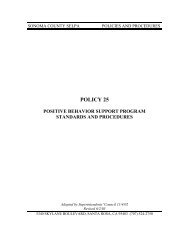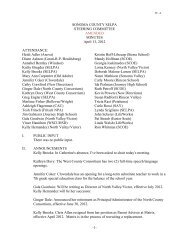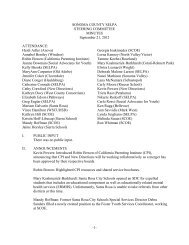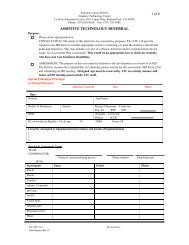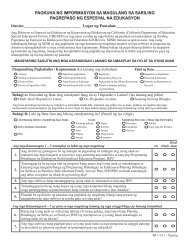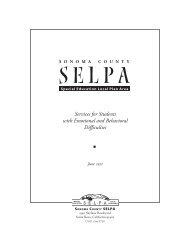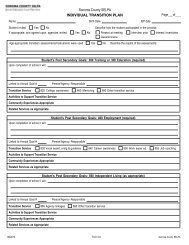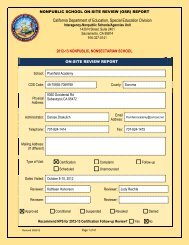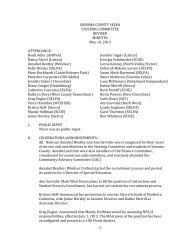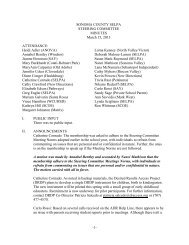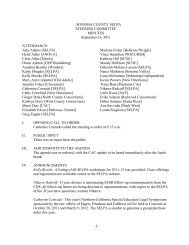Letters to Parents - Sonoma County SELPA
Letters to Parents - Sonoma County SELPA
Letters to Parents - Sonoma County SELPA
Create successful ePaper yourself
Turn your PDF publications into a flip-book with our unique Google optimized e-Paper software.
Dear <strong>Parents</strong>:<br />
The Individuals with Disabilities Education Act (IDEA) and the No Child Left Behind<br />
Act (NCLB) require that students with disabilities be included in statewide testing. In<br />
California, this is called the Standardized Testing and Reporting (STAR) program. Until<br />
last year a student with a disability <strong>to</strong>ok one of two tests:<br />
1. California Standards Test (CST) with or without accommodations and/or<br />
modifications. All general education students and most students with disabilities take the<br />
CST.<br />
2. California Alternate Performance Assessment (CAPA). The CAPA is designed<br />
primarily for students with the most significant cognitive disabilities.<br />
Starting in the spring of 2008 for students with disabilities in grades 3-5, a new test called<br />
the California Modified Assessment (CMA) was available as another option. This year<br />
the CMA will be expanded <strong>to</strong> include students in grades 6-8 for English-Language Arts,<br />
grades 6-7 for mathematics and grade eight for science. The CMA differs from the CST<br />
in the following ways:<br />
1. While the questions are aligned <strong>to</strong> state standards, they are less challenging than the<br />
questions on the CST.<br />
2. The reading passages are shorter in length than the ones on the CST.<br />
3. The formatting of the questions in the test booklet is designed <strong>to</strong> provide less visual<br />
distraction than that of the CST. For example, there is additional white space and the font<br />
sizes are larger.<br />
4. On multiple choice questions there are three answer choices instead of the four<br />
choices on the CST.<br />
5. The CMA uses graphics for many items as opposed <strong>to</strong> the CST.<br />
Attached are samples that illustrate the differences between the CST and the CMA.<br />
In order for your child <strong>to</strong> be eligible <strong>to</strong> take the CMA, he/she must meet the following<br />
criteria:<br />
1. He/she must have taken the CST in a previous year and scored Below Basic or Far<br />
Below Basic in either English-Language Arts or Math.<br />
2. Based on the results of other testing and data, he/she will not achieve grade-level<br />
proficiency and will not receive a proficient score on the CST, even with<br />
accommodations.
3. You, as parents, must be informed about the CMA and be involved in the decision <strong>to</strong><br />
have your child take the CMA through the IEP team process.<br />
You are receiving this letter because we believe that your child may be eligible <strong>to</strong> take<br />
the CMA this spring and want <strong>to</strong> ensure that you are informed about your options.<br />
An IEP team meeting will be held or an IEP amendment will be developed for your<br />
consent <strong>to</strong> determine if your child is eligible <strong>to</strong> take the CMA in the spring of 2009.<br />
Also attached is a brochure developed by the California Department of Education that<br />
further explains the statewide testing process for students with disabilities.<br />
If you have any questions, please contact:




